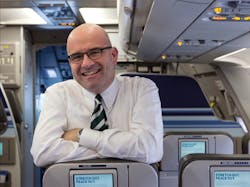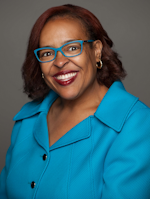Industry Insider: Marty St. George, Executive Vice President – Commercial & Planning JetBlue Airways
Marty St. George was promoted to executive vice president – commercial & planning for New York-based JetBlue Airways in February 2015. In that job, he is responsible for airline and network planning, marketing, sales and revenue. He previously served as the airline’s senior vice president - commercial.
St. George joined JetBlue in July 2006, serving in roles including senior vice president of marketing and commercial strategy and vice president of planning. Before coming to JetBlue, he was managing director and director of network planning at United Airlines. He also served as senior director of marketing and director of route planning at US Airways.
St. George spoke to Airport Business about growth in its focus cities, partnering with new and existing airports, the move back into Atlanta and its Caribbean network.
Airport Business: During your investor day talk in December 2016, there was a slide that illustrated the 2007-2017 available seat miles in JetBlue’s focus cities. Numbers for Long Beach, Los Angeles, JFK and San Juan had gone down but Boston, Fort Lauderdale and Orlando were up. How do you explain these changes?
Marty St. George: I don’t think any have actually shrunk. This company has almost doubled its size, so I think the real answer is that the growth has been concentrated. But there's growth in each market, which is not showing up in market destinations.
AB: When you're looking at a new city or an airport is trying to get JetBlue to come what are some of the boxes that you check off?
MS: We are at 100 cities right now, so we know the new city process pretty well. We have a very deliberate process where we do a lot of research on our own. We look at market size and if the market has been growing or shrinking. Pricing is also very important. We want to see a good business-leisure mix that we can stimulate by cutting prices. When we see a city really coming into its own, that’s when we have conversations with the service development people or airport directors.
We're in constant contact with between 16 and 20 cities that are trying to put themselves into the bullpen as the next place we go. We build those relationships over time. When we get down to the short list — and we're thinking next year it may be four cities — that's where we really kick into our local outreach. That includes things like visiting the cities, talking to large corporations and looking at standard travel patterns.
AB: Once you've decided that you're going to go in a city, how do you work with airports to ensure that your infrastructure, marketing and partnership needs are met when it comes to getting the service off the ground and running?
MS: One great example of that is Atlanta. Atlanta had been very high on the list for our corporate customers in Boston as far as where they'd like us to go next. But Atlanta, as big as the airport is, has significant gate challenges. We've been working with the city for years trying to find a gate solution that works for us. The original gates offered were ones with hold rooms that fit only 15 or 20 people. We said it's not negotiable. We can’t fly 150-seat airplanes in and out of those small gates. JetBlue is about is delivering the best service experience of any airline in North America and we couldn’t provide great service out of the gates they wanted to give us. Now we're finally going to be on Concourse E. We don’t love it, but it's the best option that we have.
AB: It's been 13 years since JetBlue was in Atlanta. What made you decide that now was the time to return?
MS: As we were thinking of the list of the cities that our corporate clients in Boston wanted, Atlanta was the next on the list. We're very deliberate in trying to make sure that we don’t bite off too many of those challenging markets all at once. So we paced them out with cities like Baltimore, Philadelphia and Cleveland.
In 2016, we did LaGuardia Airport, which was high on our corporate list. It's been fantastic. It did exactly what we've thought it would do. When we entered the market, the walk-up fare was $443. The walk-up fare right now is $129. With LaGuardia’s strong business mix, we can be profitable with that fare.
AB: JetBlue’s numbers on structured savings will be from $55 million to $65 million from airports. How will the airline achieve that?
MS: The best way to achieve that is through a process of building efficiencies. Take the new lobby at JFK Airport as an example. It's gone to all self-bag tagging. On a peak day you could stand in a 30-minute line to get a tag onto your bag. Now every kiosk can handle it. It’s so much faster to get through the lobby and it also require a lot fewer crew members.
Right now we have that in JFK, Fort Lauderdale and San Juan. It’s going to be moving across the rest of the system as well.
AB: What’s going on with your Caribbean flying, especially out of San Juan?
MS: It was big news in 2016 and will be in 2017. We've opened a lot of cities in the Caribbean and we started flights to Cuba. Cuba is unique in that we can't follow a playbook like we do in other cities. Cuba, in the long term, has incredible business potential for JetBlue, similar to how the Dominican Republic has exploded in the last 20 years.
We have almost every Caribbean island that we're going to be flying to already covered. Now the focus is adding new destinations from the best stations that we're already in. For example, we've been in Aruba for probably 10 years, but we just started service to there from Fort Lauderdale in 2016. We connected the dots.
AB: Airport-wise, what are JetBlue’s priorities in 2017?
MS: We've already talked about growth, but we’re also looking at maintaining our partnerships and making sure that service levels in our airports are the way we want them so that passengers are having a good experience before they get in the air.
At Fort Lauderdale, there’s been a lot of money spent to fix up Terminals 3 and 4. We've talked about taking Fort Lauderdale up to 140 flights a day and beyond, and we're going to need to do that with some help from the county. They are building a new international wing in Terminal 1 and I think we have the right to use a couple of those gates for our international operations.



